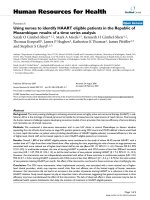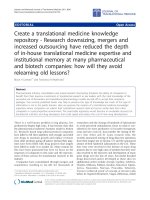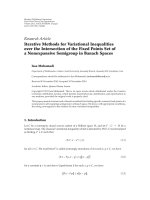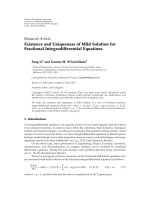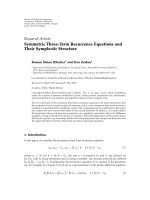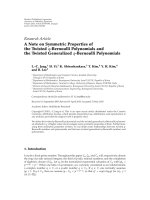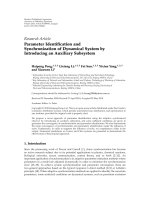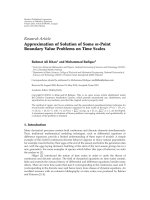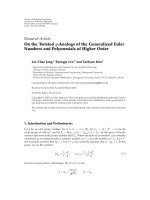Báo cáo sinh học: "Research downsizing, mergers and increased outsourcing have reduced the depth of in-house translational medicine expertise and institutional memory at many pharmaceutical and biotech co" pdf
Bạn đang xem bản rút gọn của tài liệu. Xem và tải ngay bản đầy đủ của tài liệu tại đây (176.25 KB, 3 trang )
EDI T O R I A L Open Access
Create a translational medicine knowledge
repository - Research downsizing, mergers and
increased outsourcing have reduced the depth
of in-house translational medicine expertise and
institutional memory at many pharmaceutical
and biotech companies: how will they avoid
relearning old lessons?
Bruce H Littman
1*
and Francesco M Marincola
2
Abstract
Pharmaceutical industry consolidation and overall research downsizing threatens the ability of companies to
benefit from their previous investments in translational research as key leaders with the most knowledge of the
successful use of biomarkers and translational pharmacology models are laid off or accept their severance
packages. Two recently published books may help to preserve this type of knowledge but much of this type of
information is not in the public domain. Here we propose the creation of a translational medicine knowledge
repository where companies can submit their translational research data and access similar data from other
companies in a precompetitive environment. This searchable repository would become an invaluable resource for
translational scientists and drug developers that could speed and reduce the cost of new drug development.
There is a well known problem in big pharma, low
productivity despite high costs. It has become clear that
the pharmaceutical industry’s business model is broken
[1]. Research-based large pharmaceutical companies
have failed to fil l their pipelines with enough successful
new drugs to maintain growth and replace revenues
from older products going off patent. Instead their pipe-
lines have been filled with drug projects that largely
have failed to make it to m arket [2]. Many reasons for
this have been postulated but here we focus on the
responses of companies to this issue and the repercus-
sions of those actions for translational research in the
industry.
Companies have consolidated through mergers and
acquisitions resulting in lay-offs for thousands of
researchers and the closing of hundreds of laboratories
to avoid perceived redundancies, focus on what is con-
sidered to be more productive or lucrative therapeutic
areas and save costs [3]. Just consider the closing of Pfi-
zer’ s Ann Arbor and St. Louis research sites, the
recently announced moving of drug discovery operations
from their largest site in Groton, CT and the announced
closure of their Sandwich Laboratories in the U.K. These
four sites were involved in the demise of many drug
projects due to very high rates of attrition but they were
also involved in the discovery and de velopment of many
great drugs over the last 25 years. Successful branded
drugs discovered and/or developed at these sites (in
alphabetical order) include Aricept, Cardura, Celebrex,
Chantix, Diflucan, Feldene, Geodon, Glucotrol, Lipitor,
Lyrica, Neurontin, Norvasc, Procardia, Selzentry,
Tarceva (achieved proof of concept at Groton Labs
before its required divestiture), Viagra, Zithromax, Zoloft
* Correspondence:
1
Translational Medicine Associates, L.L.C., Stonington, CT 06378, USA
Full list of author information is available at the end of the article
Littman and Marincola Journal of Translational Medicine 2011, 9:56
/>© 2011 Littman and Marincola; licensee BioMed Central Ltd. This is an Open Access article distributed under the terms of the Creative
Commons Attribution License (http:/ /creativecommons.org/licenses/by/2.0), which permits unrestricted use, distribution, and
reproduction in any medium, provided the original work is properly cited.
and Zyrtec to name just some. Consider the lessons
learned from both the failuresandthesuccesses.Pfizer
was one of the first companies to embrace the field of
experimental medicine and then translational medicine
as specialized functions during the drug discovery and
early drug development process [4]. They invested
millions of dollars in biomarker development and the
qualification of human pharmacology models to enable
data-driven decisions for drugs with novel targets but
these were often not put into the public doma in. Now
consider the loss of institutional memory as leaders in
these areas left the company either as a result of e arly
retirement or attractive severance packages as downsiz-
ing and consolidation ruled.Thisalsooccurredatmany
other companies including Merck, Lilly, Roche and G SK
[5]. Many of the hard won lessions of translational
research and early drug development could well be lost
and the more recent successful strategies for coping with
high attrition rates may have to be relearned.
One of the reasons Littman and Krishna decided to
cre ate a textbook entitled Translational Medicine and
Drug Discovery was to provide a guidebook for current
and future translational medicine scientists and to
clearly describe successful strategies for early drug
development that utilize biomarkers and state of the art
technologies. This book partial ly addresses the issue
described above. It includes sections and chapters
describing successful translational strategies for early
drug development, principles of biomarker qualification
and utilization in drug discovery and development, in-
depth examples of translational research in six different
therapeutic areas, translational imaging technologies,
modeling and simulation and examples of pre-competi-
tive collaborations between companies in many areas
including biomarkers and drug safety [6]. Another simi-
lar book, Biomarkers in Drug Development,also
attempts to serve as a “handbook of practice, application
and strategy” for translational researchers [7]. However,
textbooks like these cannot do the job alone and they
are static. They are not regularly updated, newer meth-
ods and biomarkers are not added and comparisons of
results between different drugs with similar mechanisms
cannot be made.
We believe that companies and other institutions
involved in translational drug research need to foster
the discipline of translational medicine, maintain a
knowledge base of their work and, when it is not
proprietary, share that knowledge through publication
and pre-competitive collaborations. It is often easier to
find the published results of translational research p er-
formed by others than it is to find the unpublished
results of translational research done within your own
institution, especially if the drug projects the research
supported were discontinued. For this reason we
advocate the creation of a searchab le knowledge reposi-
tory for human translational research. This database
could be maintained by a consortium of drug companies
that voluntarily submit data and it would include human
biomarker data, translatable human pharmacology
models and other types of clinical methods that have
been used in humans to measure drug responses. A
structured database like this could be initially populat ed
by data from failed drug projects with no significant loss
of competitive advantage to contributing companies and
institutions. Also, time is not on our side. The opportu-
nities to capture this type of information decreases
almost monthly as companies continue to reorganize,
downsize and c onsolidate. It can only happen if those
involved in these projects are still employed and have
access to their companies’ data.
Imagine the benefits if this human translational med-
icine database existed today and could be searched by
drug target, pathway, biomarker, disease, therapeutic
area, challenge agent and translational pharmacology
model name or description. It would become the first
place to look when developing a translational research
plan for a new drug project. It could potentially pre-
vent reinventing proven clinical methods a nd replicat-
ing past biomarker and human model qualification
efforts. Often there are multiple choices for achieving
proof of mechanism for new drugs and this database
would simplify the choice when an acceptable existing
method or biomarker can be easily found. Use of the
database could also translate into reduced costs and
reduced time for drug development and enable the
comparison of results from newer drugs with those
from past drug projects. These comparisons will also
aid decision-making based on the data from existing
projects compared to older failed or successful pro-
jects. We urge companies to strongly consider adopt-
ing this recommendation and finding a home for the
database perhaps under the auspices of an existing
consortium such as The Biomarker Consortium mana-
ged by the Foun dation for the Natio nal Institutes of
Health (FNIH) [8].
Author details
1
Translational Medicine Associates, L.L.C., Stonington, CT 06378, USA.
2
Infectious Disease and Immunogenetics Section (IDIS)-Department of
Transfusion Medicine, Clinical Center, National Institutes of Health, Bethesda,
MD 20892, USA.
Received: 29 April 2011 Accepted: 10 May 2011 Published: 10 May 2011
References
1. Garnier J-P: Rebuilding the R&D Engine in Big Pharma. Harvard Business
Review 2008, 1-9.
2. CMR International 2009 Pharmaceutical R&D Factbook, CMR International, a
Thomson Reuters Business: 2009.
3. Arnst C: Drug Mergers: Killers for Research, Bloomberg Business Week.
News Analysis 2009.
Littman and Marincola Journal of Translational Medicine 2011, 9:56
/>Page 2 of 3
4. Littman BH, Williams SA: Opinion: The ultimate model organism: progress
in experimental medicine. Nature Reviews Drug Discovery 2005, 4:631-638.
5. Gertz B: Impact of the Crisis in Clinical Research on New Drug
Development, in Special Report: “The Crisis in Clinical Research”
Proceedings of a Conference Sponsored by the AFMR April 14, 2009 in
Washington, DC. The American Federation for Medical Research; 2010,
20-24[ />jim200301.pdf].
6. Littman BH, Krishna R, Editors: Translational Medicine and Drug Discovery.
Cambridge University Press, New York; 2011.
7. Bleavins MR, Rahbari R, Jurima-Romet M, Carini C, Editors: Biomarkers in
Drug Development: A Handbook of Practice, Application, and Strategy.
John Wiley and Sons, Inc., Hoboken, NJ; 2010.
8. The Biomarker Consortium:[ />doi:10.1186/1479-5876-9-56
Cite this article as: Littman and Marincola: Create a translational
medicine knowledge repository - Research downsizing, mergers and
increased outsourcing have reduced the depth of in-house translational
medicine expertise and institutional memory at many pharmaceutical
and biotech companies: how will they avoid relearning old lessons?
Journal of Translational Medicine 2011 9:56.
Submit your next manuscript to BioMed Central
and take full advantage of:
• Convenient online submission
• Thorough peer review
• No space constraints or color figure charges
• Immediate publication on acceptance
• Inclusion in PubMed, CAS, Scopus and Google Scholar
• Research which is freely available for redistribution
Submit your manuscript at
www.biomedcentral.com/submit
Littman and Marincola Journal of Translational Medicine 2011, 9:56
/>Page 3 of 3
